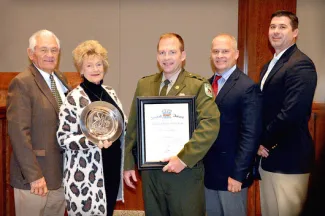
Representatives of Shikar-Safari Club International recognized Lt. Casey Young, Game Warden Supervisor based in Murray County, as Oklahoma’s Wildlife Officer of the Year for 2019. The award was presented during Monday’s meeting of the Oklahoma Wildlife Conservation Commission in Oklahoma City.
Shikar-SCI members Suzie and Bill Brewster presented Young with a commemorative metal plate, framed certificate and pin. They pointed out that the award is even more special because the honoree is nominated by his or her peers.
“I’m super honored to have this,” Young said. “There are lots of good guys out there that I get to work with, and to be nominated is awesome just by itself.”
Col. Nathan Erdman, Law Enforcement Chief for the Oklahoma Department of Wildlife Conservation, told Commissioners about some of Young’s accomplishments that led to the honor. Young not only takes care of his regular duties as the Game Warden in his county, but he is also one of few defensive tactics instructors for the Law Enforcement Division while serving as the supervisor for a half-dozen other Game Wardens in his district.
“To be recognized as the best Game Warden for the year on top of being a supervisor is pretty outstanding,” Erdman said. And he cited two examples of how Young has distinguished himself in service: He was able to save the lives of two children who were severely injured in a vehicle accident, and he stopped a would-be assailant with a knife who was planning to harm a deputy.
Also, Commissioners heard an update on a yearlong comprehensive license study from Legislative Liaison Corey Jager. Research from Southwick Associates has concluded, and recommendations for streamlining and simplifying the Department’s hunting and fishing licensing processes are expected soon.
“The big focus is customer service,” Jager said, explaining that a complicated licensing system creates challenges in recruiting, retaining and reactivating hunters and anglers. One example: The definition of “youth” varies greatly across various license types. The study’s goal is to simplify the current system that offers more than 150 various licenses and permits.
Another focus is pricing for licenses. The Department has not raised license prices across the board in 14 years, even though most of the Department’s funding is tied directly to license sales. The study is expected to suggest how the Department could adjust prices to continue to attract hunters and anglers.
In other business, Commissioners:
- Learned about Oklahoma’s deer herd management strategy in a presentation from Dallas Barber, Big Game Biologist for the Wildlife Department. Barber said a downward trend in doe harvest seen over the past few years isn’t desirable for optimum deer herd health. He also pointed out some positive and negative effects that are possible if the Commission decides in February to approve a proposed extension of deer gun season by adding seven days to the end of the current 16-day season.
- Heard comments from several people who spoke about deer numbers and how their farming operations are being affected in Beckham County.
- Received a summary presentation on a study of how residents perceive black bears in various areas of eastern Oklahoma. Study author Matty Cleary holds a master’s degree from Oklahoma State University. He said populations of black bears exist in southeastern Oklahoma (about 1,300 bears) and in east-central Oklahoma (about 100 bears). Residents near more urban areas had higher positive attitudes toward black bears, and acceptance for black bears was highest around Tahlequah within the bounds of the east-central bear population. The study compliments previous research indicating the east-central black bear population cannot support a hunt due to biological constraints. Perception of risk from bears had a significant impact on acceptance. The study recommends distributing information on how to reduce conflicts with black bears to landowners in this area, in order to reduce risk perception.
- Heard Director J.D. Strong’s regular report on various division activities in the Department, along with updates on state legislative matters. Strong announced the opening of the annual public comment period on proposed rule changes that will be considered by Commissioners in February. For more information or to comment online, go to http://www.wildlifedepartment.com/public-meeting.
The Oklahoma Wildlife Conservation Commission is the eight-member governing board of the Oklahoma Department of Wildlife Conservation. The Commission establishes state hunting and fishing regulations, sets policy for the Wildlife Department and indirectly oversees all state fish and wildlife conservation activities. Commission members are appointed by the governor and confirmed by the Oklahoma Senate.
The next scheduled Commission meeting will be 2 p.m. Monday, Jan. 6, 2020, at Department headquarters, 1801 N. Lincoln Blvd., Oklahoma City.